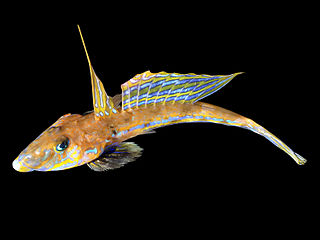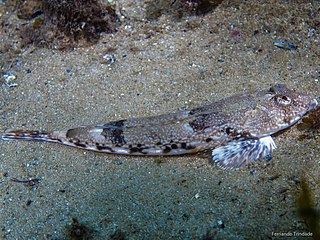
Callionymus is a genus of dragonets found mostly in the Indian and Pacific oceans with a few species occurring in the Atlantic Ocean.

Callionymus bairdi, the Lancer dragonet, Baird's dragonet, coral dragonet or St Helena dragonet, is a species of dragonet native to the warmer waters of the Atlantic Ocean where it occurs at depths of from 1 to 91 metres. In the western Atlantic it occurs from Cape Hatteras southwards along the east coast of North America. including Bermuda and the Bahamas, into the Gulf of Mexico and throughout the Caribbean Sea. It has also been recorded from Ilha da Trindade off Brazil. In the eastern Atlantic it has been recorded from the Cape Verde Islands, Ascension Island, St. Helena, and Sao Tome e Principe in the Gulf of Guinea. This species grows to a length of 11.4 centimetres (4.5 in) TL.
Callionymus belcheri, Belcher's dragonet or the flathead dragonet, is a species of dragonet native to the Pacific Ocean waters off of Australia and Papua New Guinea where it occurs at depths of from 18 to 36 metres.

Callionymus beniteguri, the White-spotted dragonet, is a species of dragonet native to the water around Japan and the East China Sea. This species grows to a length of 16 centimetres (6.3 in) SL. This species is of importance to local commercial fisheries.
Callionymus draconis, the Japanese spiny dragonet, is a species of dragonet native to temperate regions of the Indian and Pacific oceans around Japan and western Australia where it occurs at depths of around 138 metres (453 ft). This species grows to a length of 9 centimetres (3.5 in) SL.
Callionymus formosanus is a species of dragonet native to the Pacific Ocean from the South China Sea as well as around southern Japan and the Chesterfield Islands. This species grows to a length of 17 centimetres (6.7 in) SL.
Callionymus gardineri, the longtail dragonet, is a species of dragonet native to the western Indian Ocean. It can be found at depths of from 30 to 180 metres. This species grows to a length of 28 centimetres (11 in) TL. The specific name honours the British zoologist John Stanley Gardiner (1872-1946).

Callionymus japonicus, the Japanese longtail dragonet, is a species of dragonet native to the western Pacific Ocean where it is found at a depth of around 208 metres (682 ft). This species grows to a length of 20 centimetres (7.9 in) SL.

The common dragonet is a species of dragonet which is widely distributed in the eastern North Atlantic where it is common near Europe from Norway and Iceland southwards. It is a demersal species that occurs over sand bottoms. It lives to a maximum age of around seven years. It is caught in bycatch by fisheries and is used in the aquarium trade.
Callionymus maculatus, the Spotted dragonet, is a species of dragonet native to the eastern Atlantic Ocean and the Mediterranean Sea where it occurs at depths of from 45 to 650 metres. This species is important to local peoples engaged in subsistence fishing.
Callionymus ochiaii is a species of dragonet found in the Pacific waters around Japan. The specific name honours the Japanese ichthyologist Akira Ochiai.

Callionymus pusillus, the Sailfin dragonet, is a species of dragonet common in the Eastern Atlantic, where it occurs on the Portuguese coast to as far north as Lisbon and south to Morroco, and also in the northern Mediterranean including the Adriatic, Aegean and Black seas as well as the coastsLebanon and Israel. It occurs on the southern Mediterranean shore as far east as Tunisia Males of this species grows to a length of 14 centimetres (5.5 in) TL while females reach a length of 10 centimetres (3.9 in) TL. In the areas of the Mediterranean where it occurs it is one of the commonest dragonet species, as it is the only species that has been recorded within many protected areas. It is a benthic species which occurs in shallow waters and prefers sandy bottoms down to 100 metres (330 ft). The males are territorial, aggressively defend their territories from other males and like other dragonets this species undergoes complex breeding behaviour which has 4 phases. This starts with courtship, the male and female then form a pair before ascending to the surface where they release eggs and milt. The spawning season runs from May to August in the Mediterranean and the eggs and larvae are pelagic. This species feeds mainly on small benthic invertebrates such as worms and small crustaceans.

Callionymus reticulatus, the reticulated dragonet, is a species of dragonet native to the northeastern Atlantic Ocean and the Mediterranean Sea where it is found at depths of from 0 to 110 metres. This species grows to a length of 11 centimetres (4.3 in) TL. This species has a flattened head and body, the head has a triangular shape with the eyes placed on the top of the head. It has two dorsal fins with the first one being triangular in shape. It has blue spots along the flanks and four saddle-like markings on their backs which have sharply defined outlines. It is similar to the common dragonet but is distinguished by its smaller size and the sharply defined border around the saddle markings on the back.

Arrow dragonet, also known as the arrow-headed darter dragonet, is a species of dragonet widespread in the Indo-West Pacific from Arabian Peninsula to the Philippines. Occurs in the Mekong delta of Viet Nam and probably also in Cambodia. This species grows to a length of 11 centimetres (4.3 in) TL. The arrow dragonet is a demersal species, which occurs on sandy substrates along coastlines, in estuaries, and in the lower courses of rivers where it feeds on worms, zooplankton and phytoplankton.

Callionymus valenciennei, Valenciennes’ dragonet, is a species of dragonet native to the Pacific waters around Japan and the Korean Peninsula where it occurs at depths of from 20 to 50 metres. This species grows to a length of 10 centimetres (3.9 in) SL. The specific name and the vernacular name honour the French zoologist Achille Valenciennes (1794-1865).
Callionymus whiteheadi, Whitehead’s deepwater dragonet, is a species of dragonet found in the Pacific waters around Indonesia. The specific name honours the ichthyologist Peter James Palmer Whitehead (1930-1992).
Callionymus alisae is a species of dragonet which was described in 2016 from a male specimen collected by a grab dredge as a depth of 90-228 m, southwest of Kavieng, New Ireland, Papua New Guinea. The specimen is yellowish in colour, becoming darker towards the tail and white on the underside, it has dark blue eyes and greyish spots on its body. It was name after the French research vessel which collected the only specimen known so far, the R.V. Alis.

Callionymus izuensis, the Izu dragonet, is a species of dragonet which is endemic to the waters around the Izu Islands of Japan. It is found at depths of 16–18 metres (52–59 ft) over substrates consisting of coarse sand, although sometimes coral rubble and broken shells may form part of the habitat. It was originally described as a subspecies of Callionymus persicus from the western Indian Ocean and has also been placed in the genus Calliurichthys by some authorities.
Callionymus brevianalis, the Small ruddertail dragonet, is a species of dragonet native to the coastal waters of Indonesia where it can be found at depths of from 0 to 6 metres. This species grows to a length of 2.1 centimetres (0.83 in) standard length.










